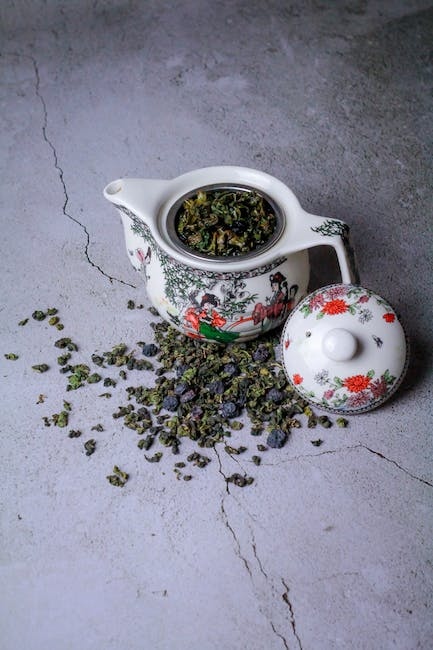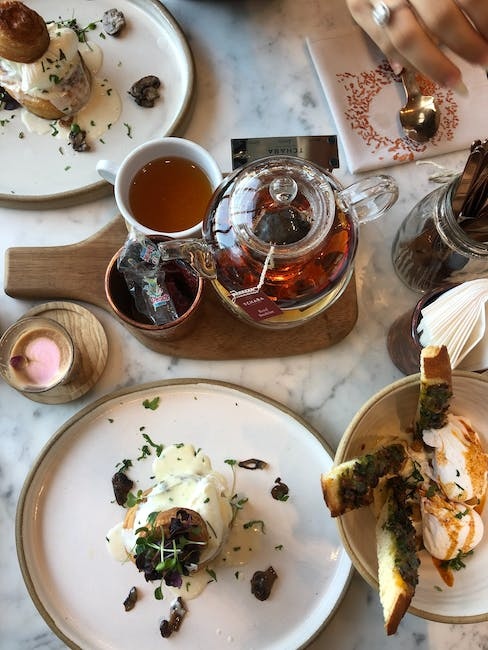The Rich and Fascinating History of Oolong Tea
Tea has been a beloved beverage for centuries, and one type that has stood the test of time is oolong tea. This tea has a long and rich history that dates back to the Ming Dynasty in China, from 1368-1644.
The Legend of the Black Dragon
The name “oolong” has an interesting origin story. It means “black dragon” in Chinese and is said to come from a legend about a tea farmer who saw a black dragon near his tea bushes. The dragon disappeared, and the next day, the farmer found his tea leaves had partially fermented and had a unique flavor. Thus, oolong tea was born.
Medicinal Purposes
Oolong tea was initially used for medicinal purposes in traditional Chinese medicine. It was believed to have various health benefits, such as aiding digestion, reducing inflammation, and improving mental alertness. In traditional Chinese medicine, oolong tea is still used today to help with various ailments.
The Art of Tea Drinking
As oolong tea gained popularity, it also became associated with the art of tea drinking and tea ceremonies in China. The Chinese culture has always placed a high value on tea and the experience of drinking it. The ceremony of preparing and serving tea is viewed as an art form and is deeply ingrained in Chinese culture.
Exportation
In the 18th century, oolong tea started to be exported to Europe and other parts of the world. It gained a reputation for its complex and nuanced flavors, which were unlike any other tea that had been experienced before.
Modern Tea Culture
Today, oolong tea is enjoyed by tea lovers all over the world. It has become an integral part of modern tea culture, with many people seeking out different varieties and flavors of oolong tea. From the traditional Chinese tea ceremony to enjoying a cup of oolong tea at home, this tea has come a long way since its origins in the Ming Dynasty.
Benefits of Oolong Tea
Aside from its rich history, oolong tea is also known for its various health benefits. Some of these benefits include:
- Reducing the risk of heart disease
- Boosting metabolism and aiding in weight loss
- Reducing inflammation in the body
- Improving mental alertness and focus
- Strengthening bones and teeth
Oolong tea is also rich in antioxidants, which help to protect the body from damage caused by free radicals. It has been shown to help lower cholesterol levels and promote healthy skin.
Conclusion
Oolong tea has a fascinating history that spans centuries and continents. From its origins in China to its popularity around the world today, this tea has a unique flavor and many health benefits. Whether you enjoy it in a traditional Chinese tea ceremony or at home, oolong tea is sure to satisfy your taste buds while also providing a host of health benefits.
Discovering the Art of Oolong Tea Production
Are you a tea fanatic looking for a new adventure? Look no further than oolong tea, a delicious and complex tea with a rich history dating back over 400 years. Unlike green or black tea, oolong tea is partially oxidized, which gives it a unique flavor and aroma. Let’s explore the fascinating production process behind this beloved tea.
The Plucking Process
It all begins with the plucking of the tea leaves, which are carefully selected for their size, shape, and color. The best leaves are often picked by hand to avoid bruising and ensure optimal flavor. These leaves are then spread out to wither and dry in the sun or indoors, which can take several hours or even a full day.
Oxidation: The Key to Oolong Tea
The partially wilted leaves are then gently shaken or tossed to bruise the edges and release some of the juices. This step is known as oxidation, which is what sets oolong tea apart from other teas. The degree of oxidation can vary depending on the desired style and flavor of the tea. Some oolongs are lightly oxidized, while others are heavily oxidized and almost resemble black tea.
Heating and Roasting
After the oxidation process, the leaves are heated or roasted to stop the oxidation process and lock in the flavor. This step can be done using various methods, such as pan-firing, baking, or charcoal roasting. The tea masters carefully monitor the temperature and time to ensure that the tea is of the highest quality.

Sorting, Grading, and Packaging
Lastly, the leaves are sorted, graded, and packaged for distribution. Some oolong teas may go through additional steps, such as rolling or shaping the leaves into unique forms or infusing them with floral or fruit flavors. The production process can take anywhere from several hours to several days, depending on the type of oolong tea being made. Skilled tea masters carefully monitor each step to ensure that the tea is of the highest quality.
Final Thoughts
Oolong tea production is a delicate and complex process that requires skill and attention to detail. Each step of the process can greatly influence the flavor and aroma of the final product, making oolong tea a truly unique and enjoyable experience for tea lovers everywhere. Whether you prefer a lightly oxidized oolong or a heavily roasted one, there’s an oolong tea out there for you. So why not try a cup today and discover the art of oolong tea production for yourself?
Discovering the Complex Flavor Profile of Oolong Tea
Oolong tea is a type of tea that lies somewhere between green tea and black tea. It is partially fermented, which gives it a unique flavor profile that is complex and varies depending on the type of oolong and how it was processed.
Flavor Profile
Generally, oolong tea has notes of fruity, floral, and nutty flavors, with hints of honey, caramel, and roasted undertones. Let’s take a closer look at each of these flavor notes:
Fruity Flavors
The fruity flavors in oolong tea can range from peach and apricot to citrus and berry notes, depending on the oolong variety and origin. This is due to the terroir, or the soil and climate conditions in which the tea is grown.
Floral Flavors
Floral flavors are often described as orchid or lilac and can be more pronounced in lighter oolongs. These flavors come from the natural floral aromas of the tea leaves.
Nutty Flavors
Nutty flavors come from the roasting process and can be reminiscent of chestnuts or almonds. These flavors are more prominent in darker oolongs and add depth to the tea’s flavor profile.
Creamy or Buttery Mouthfeel
Some oolongs can also have a creamy or buttery mouthfeel, adding another layer of complexity to the flavor profile. This mouthfeel comes from the tea’s natural oils and can be more prominent in higher quality oolongs.
Influencing Factors
The flavor profile of oolong tea can also be influenced by the water temperature, steeping time, and brewing method used. To get the most out of your oolong tea, it is important to experiment with different brewing techniques and find the one that best suits your taste preferences.
Conclusion
Oolong tea is a unique and complex tea that offers a wide range of flavors and aromas. Whether you prefer fruity, floral, nutty, or creamy notes, there is an oolong tea that is sure to satisfy your taste buds. So why not give it a try and discover the wonderful world of oolong tea?
Discover the Amazing Health Benefits of Oolong Tea
Are you looking to boost your health and wellness? If so, you might want to consider incorporating oolong tea into your diet. This traditional Chinese tea has been enjoyed for centuries and is packed with numerous health benefits. Here are some of the amazing health benefits of oolong tea:
1. Weight Loss
Are you looking for a natural way to lose weight? Oolong tea may be the answer. This tea has been shown to increase metabolism and fat oxidation, which can help with weight loss. Studies have found that drinking oolong tea regularly may help to reduce body fat and improve body composition.
2. Reduced Risk of Chronic Diseases
Oolong tea contains polyphenols, which have been linked to reducing the risk of chronic diseases such as heart disease, diabetes, and cancer. These powerful antioxidants can help to prevent cell damage and reduce inflammation in the body.
3. Improved Heart Health
Drinking oolong tea may help to improve heart health by reducing cholesterol levels and inhibiting the accumulation of plaque in the arteries. This can help to reduce the risk of heart disease and stroke.
4. Powerful Antioxidants
Oolong tea is also packed with antioxidants, which can help to prevent damage to cells and reduce inflammation in the body. Antioxidants are essential for overall health and wellness.
5. Anti-Inflammatory Properties
Oolong tea has been found to have anti-inflammatory properties, which can help with conditions such as arthritis. This tea can help to reduce inflammation throughout the body, which can lead to improved health and wellness.
6. Improved Brain Function
Studies have also found that drinking oolong tea may help to improve brain function and reduce the risk of cognitive decline. This tea contains caffeine and L-theanine, which can help to improve mental alertness and focus.
While oolong tea has numerous health benefits, it is important to note that some studies have conflicting results. More research is needed to fully understand the health benefits of oolong tea. However, incorporating this tea into your diet may be a great way to boost your overall health and wellness.
How to Enjoy Oolong Tea
Oolong tea is easy to incorporate into your daily routine. Simply steep the tea in hot water for 3-5 minutes and enjoy! Oolong tea can be enjoyed hot or cold, and can be sweetened with honey or other natural sweeteners if desired.
Conclusion
Oolong tea is a delicious and healthy beverage that offers numerous health benefits. From weight loss to improved heart health and brain function, this tea is a great addition to any diet. So why not try incorporating oolong tea into your daily routine today?


Leave a Reply